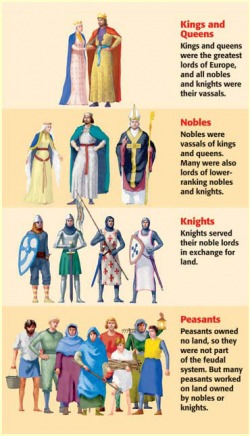

He hopes this is not happening at a lot of other places around the world, but large portions of urban America appear to have fallen into an endless Doom/Gloom cycle, sort of a Doom/Gloom wallow.

PG will remind one and all that he does not necessarily agree with everything he posts here. Link to the rest at The Los Angeles Review of Books Evgeny Morozov describes their dominance as a “hyper-modern form of feudalism.” The economic scale and impact of these tech super giants, or, overlords, is greater than that of most so-called sovereign states. Apple, Facebook, Microsoft, Amazon, and Alphabet (the parent company name for Google) together are worth more than most every country in the world (except the United States, China, Germany, and Japan).
#END OF FEUDALISM CHART FREE#
This theme has increased in prominence as a handful of tech companies have become ever richer and more extractive, turning their owners into billionaires on the basis of the cheap labor of their workers, the free labor of their users, and the tax breaks bestowed on them by cities desperate to attract jobs. Already in 2010, in his influential book, You Are Not a Gadget, tech guru Jaron Lanier observed the emergence of peasants and lords of the internet. The threat of centralization and the threat to private property are the ideological elements that remain the same.Ī number of technology commentators share the libertarian/conservative critique of technology’s role in contemporary feudalization even as they don’t embrace fossil fuels and suburbia. High tech, finance, and globalization are creating “a new social order that in some ways more closely resembles feudal structure - with its often unassailable barriers to mobility - than the chaotic emergence of industrial capitalism.” In this libertarian/conservative imaginary, feudalism occupies the place of the enemy formerly held by communism. Unlike the specter of serfdom haunting Friedrich Hayek’s attack on socialism, Kotkin locates the adversary within capitalism. The only way to avoid this neofeudal nightmare is by subsidizing and deregulating the high-employment industries that make the American lifestyle of suburban home ownership and the open road possible - construction and real estate oil, gas, and automobiles and corporate agribusiness. A property-less underclass will survive by servicing the needs of high earners as personal assistants, trainers, child-minders, cooks, cleaners, et cetera. Drawing from libertarian economist Tyler Cowen’s emphasis on the permanence of extreme inequality in the global, automated economy, the conservative geographer Joel Kotkin envisions the US future as mass serfdom. Over the past decade, “neofeudalism” has emerged to name tendencies associated with extreme inequality, generalized precarity, monopoly power, and changes at the level of the state. Wark’s question invites a thought experiment: what tendencies in the present indicate that capitalism is transforming itself into something worse? If we’ve rejected strict historical determinism, we should be able to consider the possibility that capitalism has mutated into something qualitatively different.

Communism was supposed to come after capitalism and it’s not here, so doesn’t that mean we are still in capitalism? Left unquestioned, this assumption hinders political analysis. IN CAPITAL IS DEAD, McKenzie Wark asks: What if we’re not in capitalism anymore but something worse? The question is provocative, sacrilegious, unsettling as it forces anti-capitalists to confront an unacknowledged attachment to capitalism.


 0 kommentar(er)
0 kommentar(er)
